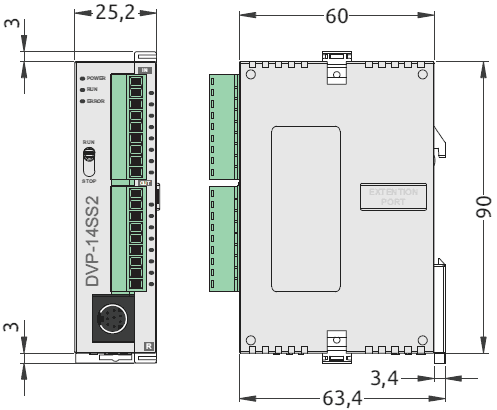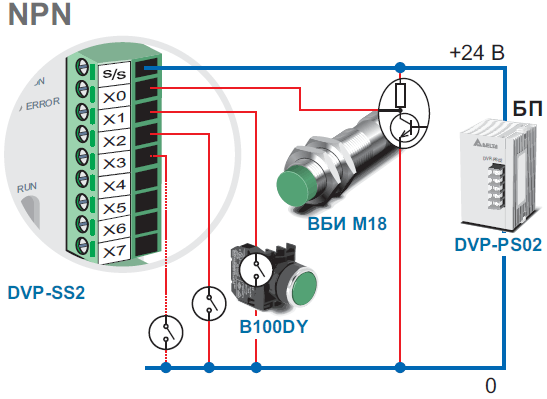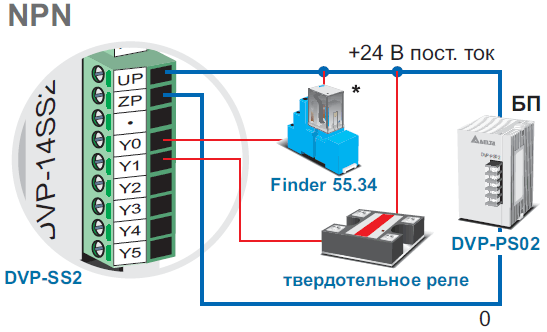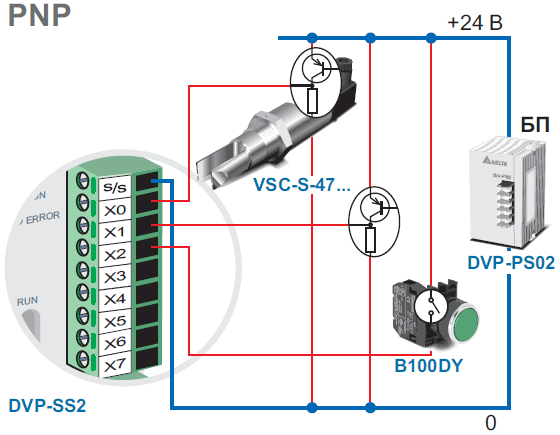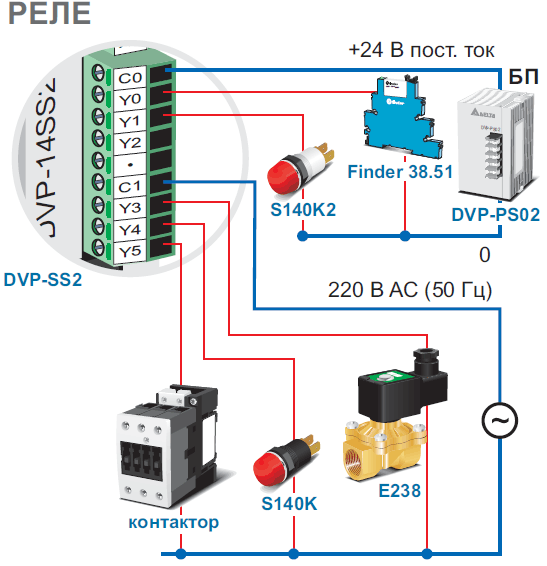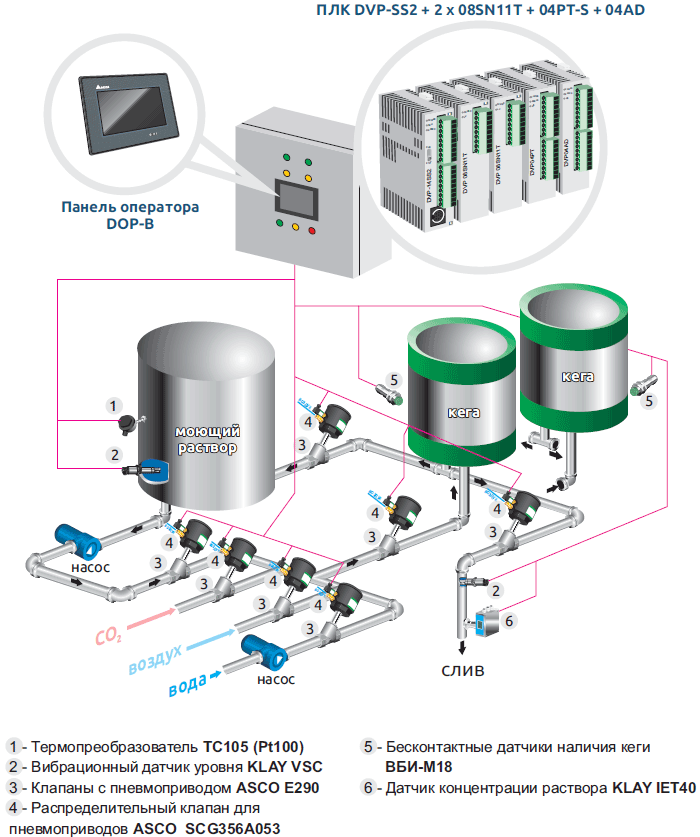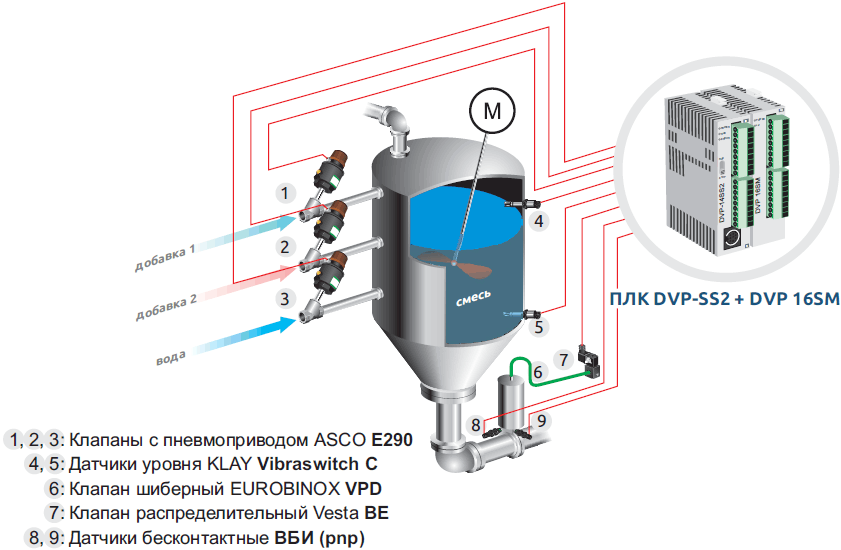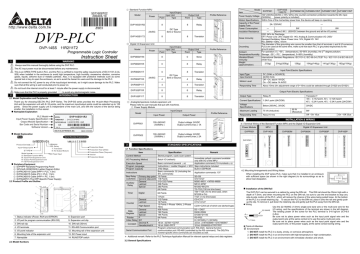14 точек дискретного ввода/вывода (8DI + 6DO)
Шина расширения до 480 вх/вых
Выгодная цена
ModBUS COMx2, RS-232 / RS-485
Высокоскоростные входы, < 20 кГц
- ЦПУ: 14 точек дискретного ввода/вывода (8DI + 6DO).
- Расширение до 480 вх/вых.
- Память: программа – 8 К шагов, регистры данных – 5 К слов.
- Время обработки инструкций: базовая – 0,35…1 мкс, прикладная (MOV) – 3,4 мкс.
- Два COM-порта: RS-232, RS-485 (Modbus, ASCII / RTU).
- 4 высокоскоростных импульсных выхода: 10 кГц.
- 8 каналов высокоскоростного счета и внешних прерываний: 4 входа по 20 кГц и 4 выхода по 10 кГц.
- Бесплатное ПО.
| Артикул | DVP14SS211R | DVP14SS211T |
|---|---|---|
| Напряжение питания | =24 В (-15%, +20%), с защитой от переполюсовки | |
| Потребляемая мощность | 1,8 Вт | |
| Входы | ||
| Тип входа | PNP или NPN | |
| Потребляемый ток | 5 мА при =24 В | |
| Время фильтрации | 10 мс (регулируется в диапазоне 0-20 мс, регистр D1020) | |
| Выходы | Реле | Транзистор |
| Максимальный ток | 1,5 А / 1 точка (5 А общий) | 0,5 А / 1 точка (3 А общий) |
| Рабочее напряжение | ~250 В, < =30 В | =5…30 В |
| Максимальная нагрузка (индуктивная) | см. руководство по эксплуатации | 15 Вт (=30 В) |
| Время реакции | около 10 мс | выкл. – вкл. (Y0-Y3) 20 мкс, (Y4, Y5) 100 мкс вкл. – выкл. (Y0-Y3) 30 мкс, (Y4, Y5) 100 мкс |
DVP14SS211R Контроллер (серия SS2) 8 вх. (NPN/PNP, 4 по 20кГц/4 по 10кГц)/6 вых. (реле 1,5А), =24VDC, макс 480вх/вых, 8К, COM1(RS-232)/COM2(RS-485)
Базовый ПЛК серии S. Простой, недорогой и очень компактный программируемый контроллер для решения несложных задач, с возможностями расширения. Один процессорный модуль поддерживает до 480 точек ввода/вывода и до 8 специальных модулей (аналоговые, температурные). Поддерживается протокол Modbus Master / Slave ASCII / RTU.
Особенности базового ПЛК со стандартным набором функций DVP-SS2
- ЦПУ: 14 точек дискретного ввода/вывода (8DI + 6DO).
- Расширение: до 480 вх/вых.
- Память: программа – 8 К шагов, регистры данных – 5 К слов.
- Время обработки инструкций: базовая – 0,35…1 мкс, прикладная (MOV) – 3,4 мкс.
- Два COM-порта: RS-232, RS-485 (Modbus, ASCII / RTU).
- 4 высокоскоростных импульсных выхода: 10 кГц.
- 8 каналов высокоскоростного счета и внешних прерываний: 4 входа по 20 кГц и 4 выхода по 10 кГц.
- Бесплатное ПО.
 |
Библиотека EPLAN для DELTA |
 |
Руководство по среде ISPSoft eng. (20130118) |
 |
Руководство по программированию DVP-PLC ES2 / EX2 / SS2 / SA2 / SX2 / SE (eng) |
 |
DVP-PLC рук. по программированию (рус) |
 |
PLC LINK описание |
 |
ISPSoft 2.04 |
 |
WPLSoft-V2.39 |
 |
COMMGR v.1.03 — коммуникационная программа |
 |
Разрешение на применение Программируемые контроллеры серии DVP, операторские панели DOP и ТР |
 |
Руководство по эксплуатации контроллеров DVP-SS |
 |
Сертификат соответствия Программируемые логические контроллеры серии AH, DVP |
 |
Сертификат средств измерений Delta DVP |
Схема подключения входов / выходов
207e7e
| Код заказа | DVP14SS211R | DVP14SS211T |
| Напряжение питания | =24 В (-15%, +20%), с защитой от переполюсовки | |
| Потребляемая мощность | 1,8 Вт | |
| ВХОДЫ | ||
| Тип входа | PNP или NPN | |
| Потребляемый ток | 5 мА при =24 В | |
| Время фильтрации | 10 мс (регулируется в диапазоне 0-20 мс, регистр D1020) | |
| ВЫХОДЫ | Реле | Транзистор |
| Максимальный ток | 1,5 А / 1 точка (5 А общий) | 0,5 А / 1 точка (3 А общий) |
| Рабочее напряжение | ~250 В, < =30 В | =5…30 В |
| Максимальная нагрузка (индуктивная) | см. руководство по эксплуатации | 15 Вт (=30 В) |
| Время реакции | около 10 мс | выкл. – вкл. (Y0-Y3) 20 мкс, (Y4, Y5) 100 мкс вкл. – выкл. (Y0-Y3) 30 мкс, (Y4, Y5) 100 мкс |
Модули расширения для ПЛК DVP-SS2
- Модуль аналогового ввода DVP04AD-S
- Модуль аналогового вывода DVP04DA-S
- Температурный модуль DVP04-PT/TC
- Модуль аналогового ввода/вывода DVP06XA-S
- Модули дискретного ввода/вывода DVP SM/SN/SP
Использование логического контроллера DVP-SS2 на рабочих примерах
Габаритные размеры, мм
Контроллер (серия SS2) 8 вх. (NPN/PNP, 4 по 20кГц/4 по 10кГц)/6 вых. (реле 1,5А), =24VDC, макс 480вх/вых, 8К, COM1(RS-232)/COM2(RS-485)
Тип выхода: Реле
Реле
Не корректная комбинация
Транзистор NPN
Не корректная комбинация
В наличии
Товар есть в наличии на нашем складе.
Характеристики товара
Общие характеристики
| Серия | SS2 |
| Тип устройства | ПЛК |
Входы и выходы
| Дискретные входы | 8 |
| Дискретные выходы | 6 |
| Тип выхода | Реле |
Интерфейсы
| RS-485 | 1 |
| Ethernet | нет |
| RS-232 | 1 |
| USB | нет |
Документация и ПО
Пользовательская документация и ПО
Допускающая к эксплуатации документация
◎ Standard Function MPU Model Model Power DVP14SS11R2 DVP-PLC 8 DVP14SS11T2 Item Output Unit Point Type 6 Profile Reference 8 6 Relay Transistor ◎ Digital I/O Expansion Unit Model Instruction Sheet Power Input/Output Input Unit Point Type Output Unit Point Type DVP08SM11N 8 0 None DVP08SN11R 0 8 Relay DVP08SN11T 0 8 Transistor Profile Reference WARNING Always read this manual thoroughly before using the DVP PLC. Power Supply Voltage Motion Specifications Capacity of the Power Supply Fuse Power Consumption Insulation Resistance DC Type Sink or Source 24VDC DVP-14SS 11R2/11T2 Programmable Logic Controller 1 Input/Output Input Unit Point Type DVP14SS DVP08SM11N DVP08SN11R/T DVP08SP11R/T DVP16SP11R/T 11R2/T2 100~240VAC 24VDC (-15%~20%) (the counter-connection protection towards the DC input (50/60Hz) power polarity is included) Within 5ms of the momentary power loss, the device will keep on operating DVPPS01 2A / 250VAC --5W 8W Above 5 MΩ (500VDC between the ground and all the I/O points) --ESD: 8KV Air Discharge EFT: Power Line: 2KV, Digital I/O: 1KV, Analog & Communication I/O: 250V Noise Immunity Damped-Oscillatory Wave: Power Line: 1KV, Digital I/O: 1KV RS: 26MHz~1GHz, 10V/m The diameter of the grounding wire cannot be smaller than that of terminals L and N (if numerous Grounding PLCs are used at the same time, make sure that each PLC is grounded respectively to the ground poles) For operation: 0℃~55℃ (temperature), 50~95% (humidity), the 2nd degree pollution. Ambient Temperature/Humidity Storage: -25℃~70℃ (temperature), 5~95% (humidity) Vibration/Shock International Standard Regulations: IEC1131-2, IEC 68-2-6 (TEST Fc) / IEC1131-2 & IEC 68-2-27 Immunity (TEST Ea) Weight 210(g) 214(g)/208(g) 128(g) 154(g)/146(g) 141(g)/136(g) 162(g)/154(g) (approximation) The AC input power must be disconnected before any maintenance. This is an OPEN-TYPE built-in PLC, and the PLC is certified to meet the safety requirements of IEC 61131-2 (UL 508) when installed in the enclosure to avoid high temperature, high humidity, exceessive vibration, corrosive gases, liquids, airbome dust or metallic particles. Also, it is equipped with protective methods such as some special tool or key to open the enclosure, so as to avoid the hazard to users and the damage to the PLC. DVP08SP11R Do not connect the AC power to any of the input/output terminals, as it might cause damage to the PLC. Make sure that all the wiring is well conducted prior to power on. DVP08SP11T Do not touch the internal circuit for at least 1 minute after the power supply is disconnected. Make sure that the PLC is properly grounded 2 , to avoid any electromagnetic noise. INTRODUCTION 2.1 Model Explanation and Peripherals Thank you for choosing DELTA’s PLC DVP Series. The DVP-SS series provides the 14-point Main Processing Unit and the expansion unit with 8~16 points, and the maximum input/output points could be extended up to 128 points. Since the power supply unit is independent of the main unit, and with the volume of the device being smaller, the installation is thus easier. Nameplate Explanation PLC Model Input Power Supply Specification Output Module Specification Bar Code and Serial Number Software Version 24VDC 4 DC Type Sink or Source 4 Relay 4 4 Transistor DVP16SP11R 8 8 Relay DVP16SP11T 8 8 Transistor Input Point Electric Specifications Input Type Input Current Motion Level Responding Time Please refer to user manuals that put with machines. ◎ Power Supply Module Input/Output Input Power Output Power 100~240VAC ( 50/60Hz ) Output voltage: 24VDC Output current (max.): 1A DC (SINK or SOURCE) 24VDC 5mA Off→On, above 16VDC On→Off, below 14.4VDC About 10ms (An adjustment range of 0~15ms could be selected through D1020 and D1021) Output Point Electric Specifications ◎ Analog/temperature module expansion unit Model Profile Reference Output Type Relay-R Current Specifications 1.5A/1 point (5A/COM) Voltage Specifications Below 250VAC, 30VDC Maximum Loading 75 VA (Inductive) Responding Time About 10 ms DVPPS01 CE Power Module MPU DVPPS01 DVP14SS Production Week Production Year (2002) Production Place (Taoyuan) Version DC Power Input Production Model 4 5 3.00 25.20 POWER 60.00 s s 6 11 7 RUN ERROR X0 X1 14 X2 X3 RUN 8 X4 10 X5 12 X6 STOP X7 C0 Y0 90.00 9 13 C1 Y1 2 C2 Y2 Y3 3 Y4 Y5 3 4.00 1. Status indicator (Power, RUN and ERROR) 8. Expansion port 2. I/O port for program communication (RS-232) 9. Expansion unit clip 3. DIN rail clip 10. DIN rail (35mm) 4. I/O terminals 11. RS-485 Communication port 5. I/O point indicator 12. Mounting rail of the expansion unit 6. Mounting hole of the expansion unit 13. DC Power input 7. Nameplate 14. RUN/STOP switch 2.3 Model Numbers Item Control Method Specification Remark Stored program, cyclic scan system Immediate refresh command available only with I/O of the MPU Basic command (several μs) Application command (10~hundredsμs) Execution Speed Program Language Instructions + Ladder Diagram + SFC Step instructions included Program Capacity 3792 Steps Built-in EEPROM Basic commands: 32 (including the Instructions Application commands: 107 STL commands) Step Relay Primary step point 10 Points S0~S9 (Latched) General step point 118 Points S10~S127 General 512+232 Points M000~M511 + M768~M999 Auxiliary Latched 256 Points M512~M767 Relay Special 280 Points M1000~M1279 64 Points T0~T63 (100 ms time base) T64~T126 (10 ms time base, when Timer Digital 63 Points M1028 is On) 1 Point T127 (1 ms time base) General 112 Points C0~C111 Latched 16 Points C112~C127 Counter 13 Points 1-Phase 10KHz, 2-Phase High-Speed C235~C254 (all of which are latched type) 7KHz General 408 Points D0 ~ D407 Data Latched 192 Points D408~D599 Register Special 144 Points D1000~D1143 Pointer P 64 Points P0~P63 Index Relay E/F 2 E (=D1028), F (=D1029) Decimal K 16 bit: -32768~+32767 32 bit: -2147483648~+2147483647 Constant Hexadecimal H 16 bit: 0000~FFFF 32 bit: 00000000~FFFFFFFF Program write/read communication port: RS-232C. General function Serial Communication Port communication port: RS-485 (controlled by the RS command). The DELTA’s inverter-specific drive commands are included as well. I/O Processing Method Periphery Equipment ◎ DVPHPP Handheld Programming Panel ◎ WPLSoft (WINDOWS) Ladder Diagram Editor ◎ DVPACAB115 Cable (HPP PLC, 1.5m) ◎ DVPACAB215 Cable (PC PLC, 1.5m) ◎ DVPACAB315 Cable (HPP PC, 1.5m) ◎ DVPAADP01 (The HPP-Specific Power Supply) 2.2 Product Profile and Outline 1 STOP 3.1 Function Specifications Batch I/O (refresh) * Additional remark: Refer to the PLC Technique Application Manual for relevant special relays and data registers. 3.2 General Specifications DVP16SP S01234567 001234567 / XXXXXXXX CYYYYYYYY S S TYPE STANDARD SPECIFICATIONS DVP08SP 0Y 0C 1Y 1C 2Y 2C 3Y 3 C Input+Output point 3 DVP08SN S0123 / XXXX S RUN Version R: Relay T: Transistor N: No Output Module Digital I/O Expansion Unit DVP08SM 0Y 0Y 1Y 2Y 3Y 4Y 5Y 6Y 7 C Output voltage: 24VDC Output current (max.): 2A DVP-PS01 Product Series On→Off 25us INSTALLATION & WIRING S01234567 /X XXXXXXX S Serial Number Explanation 9W Off→On 15us S01234567 001122345 /X XXXXXXX CYCYCYYYY S Model 100~240VAC ( 50/60Hz ) 30VDC 4.1 Terminal Wiring of the Standard Function MPU and the Digital I/O Expansion Unit V4.9 DVPPS02 Transistor-T 55℃ 0.1A/1point, 50℃ 0.15A/1point 45℃ 0.2A/1 point, 40℃ 0.3A/1 point (2A/COM) 90 W (Resistive) 4 Model Explanation Model type S: Standard Function MP U M: Input Point Expansion Unit N: Output Point Expansion Unit P: I/O Point Expansion Unit --- POWER 4.2 Mounting Arrangements and Wiring Notes When installing the DVP series PLC, make sure that it is installed in an enclosure with sufficient space (as shown in the right diagram) to its surroundings so as to allow heat dissipation. 50mm or more 50mm or more DVP MPU 50mm or more 50mm or more Installation of the DIN Rail The DVP-PLC can be secured to a cabinet by using the DIN rail. This DIN rail should be 35mm high with a depth of 7.5mm, and when mounting the PLC on the DIN rail, be sure to use the end bracket to stop any side-to-side motion of the PLC, which will reduce the chance of the wires being pulled loose. At the bottom of the PLC is a small retaining clip. To secure the PLC to the DIN rail, place it onto the rail and gently push up the clip. To remove it, pull down the retaining clip and gently pull the PLC away from the DIN rail. Wiring Use the 22-16AWG (1.5mm) single-core bare wire or the multi-core wire for the I/O wiring, and the specifications of the terminal are shown in the left diagram. 22-16AWG The twisting power of the screw for the PLC terminal is 5~8 kgf-cm (4.3~6.9 in-lbs). Be sure not to place power wires such as the input point signal wire and the output point wire at the same conduit or to use the same multi-core wire. < 1.5mm Be sure not to place power wires such as the input point signal wire and the output point wire, or the power supply, at the same conduit during wiring. Points of Attention Environment 1. DO NOT install the PLC in a dusty, smoky, or corrosive atmosphere. 2. DO NOT install the PLC in an environment with high temperature or high condensation. 3. DO NOT install the PLC in an environment with immediate vibration and shock. DVP-**-**-11-R2 Construction 1. Avoid the accidental drop of conductive debris into the PLC during screwing and wiring. 2. Allow a minimum space of 50mm between the PLC and other control components, and keep the PLC away from the high-voltage lines and the power equipment. 4.3 LED S/S X0 X1 Sink = the common terminal for the current inflow S/S Source = the common terminal for the current outflow S/S X0 S/S Sinking ◎ Wiring Equivalent Circuit of the Input Point Wiring Circuit +24V 24VDC DC Type (DC Signal IN) 0V SINK +5V S/S +24V OV X0 24VDC S/S X0 X1 X2 Sink Type SINK Mode Equivalent Circuit of the Input Point S/S X0 Y2 Y3 Y4 Y5 Fig. B Transistor output Example (sink output wiring) 1 4 5 6 6 C0 Y0 C1 Y1 C2 Y2 Y3 MC1 MC2 2 3 3 Fig. C 5 Y4 Y5 DC Power Supply Emergency Stop Circuit Protection Fuse Since the transistor module output is of the Open Collector output and that if Y0 is set as the pulse series output (use the PLSY command), and in order to ensure that the transistor module is functioning normally, the output elevation resistance has to be great enough to maintain the an output current greater than 0.1A. Since the transistor module output is of the Open Collector output and that if Y1 is set as the pulse series output (use the PWM command), and in order to ensure that the transistor module is functioning normally, the output elevation resistance has to be great enough to maintain the an output current greater than 0.1A. Mutually Exclusive Output: utilize the external circuit to form an interlock, and accommodating the internal program of the PLC, to provide safety protection when unexpected errors occurred. 6.2 TRIAL RUN Power Indication 1. At the front of the MPU or the expansion unit, there is a “POWER” LED. When the MPU is powered On, the LED (in green) will be on. If the indicator is not on when the MPU is powered up, it means that there is some problem with DC power supply of the PLC, and it is thus important to check whether the wirings of the +24V and the 0V terminals are properly conducted. If the ERROR LED is blinking swiftly, it means that the +24V power supply to the PLC is insufficient. 2. If the other indicator, “L. V”, that locates at the front of the expansion unit is on, it means that the input power voltage to the expansion unit is insufficient, and the output from the expansion unit should be prohibited. Operation & Test 1. If the ERROR LED of the MPU is not blinking, use the peripheral device to give the RUN command, and the RUN indicator will then be on. 2. HPP could be utilized to monitor the settings and the registered values of the timer, the counter and the data register during operation, and moreover, to force the I/O contacts to conduct the On/Off motion. If the ERROR LED is on (but not blinking), it means that the setting of the user’s program has exceeded the preset overtime limit, and users have to double check the program and perform the On/Off function again. (The PLC is then back at STOP automatically) The PLC I/O Responding Time: The total responding time of the PLC from the input signal to the output motion is calculated as follows: Output motion delay time SOURCE +5V 0V C2 The Transistor Output Circuit Wiring ◎ 24VDC 0V +24V Y1 “Responding Time” = “input interface delay time” + “user’s program scan time” + “output motion delay time” 10ms (factory setting), 0~15ms adjustable. Refer to the usage on special Input interface delay time registers D1020~1021 for detail. User’s program scan Refer to the usage on special register D1010 for detail. time Wiring Circuit +24V DC Type (DC Signal IN) C1 Preparation 1. Make sure that the power wiring and the I/O wiring are both conducted properly before the power is turned On. And be advised not to supply AC110V or AC220V into the I/O terminals, or it might short circuit the wiring and would cause direct damage to the PLC. 2. After using the peripheral devices to write the program into the MPU and that the ERROR LED of the MPU is not on, it means that the program in use is legitimate, and it is now waiting for the user to give the RUN command. 3. Use HPP to execute the forced On/Off test of the output contact. S/S Sourcing X0 Y0 TRANSISTOR OUTPUT Fig. A 5V Wiring of the Input Point The input signal of the input point is of the DC power DC input, and there are two types of wiring to the DC type: SINK and SOURCE. ◎ The DC Type, there are two types of wiring to the DC type: SINK and SOURCE, and they are defined as follows: C0 When actual wiring is conducted at the output terminal, pay special attention to the wiring at the common end. Take DVP14SS11R2 as an example, the output terminal Y0 utilizes the common end C0, and Y2 uses C1, whereas Y2~Y5 use C2, as shown in Fig. C. Isolation Circuit: the photocoupler is utilized as the signal isolation between the internal circuit of the PLC and input module. The Relay Output Circuit Wiring Surge Absorbing Diode: increase the contact life of the relay Emergency Stop: use the external switch Fuse: use the fuse with a 5~10A capacity at the common end of the C0 Y0 C1 Y1 C2 Y2 Y3 Y4 Y5 2 3 output contact to protect the output circuit. Surge Absorber: reduce the interferences from the AC loading 8 1 5 MC1 MC2 DC Power Supply 3 9 Indicator: neon indicator 2 AC Power Supply 2 3 4 6 7 5 Incandescent Lamp (resistive loading) Mutually Exclusive Output: utilize the external circuit to form an interlock, and accommodating the internal program of the PLC, to provide safety protection when unexpected errors occurred. X2 Safety Guidelines Since the PLC is in control of numerous devices, motion of either one device could affect the motion of other devices, and the breakdown of either one device would consequently be detrimental to the whole auto control system, and danger will thus be resulted. What follow is the recommended wiring for the power input: AC Power Loading Power Circuit Protection Fuse (2A) 5 Power Indicator 1 7 4 Emergency Stop An “Emergency Stop” button is installed to prevent unexpected 8 Guard 2 situations. If it does occur, the power will be disconnected Limit immediately. MC 3 MC Isolation Unit of the System Circuit 24V 0V 1 Utilize the electromagnetic contactor and the relay to be the isolation unit of the power circuit to prevent the possible instability of the system when the power is supplied on and off. L N 24V 0V 6 DVPPS01/24VDC Power Module DVP PLC Power Supply: 24VDC < 0.3A C0 2.5A DC/DC LED Y0 T R G RELAY OUTPUT ◎ +24V 24G POWER RY C0 20.4VDC~28.8VDC OV LOAD Y0 Wiring and Specifications of the Power Terminals This PLC model is of the DC power input, and when the power is supplied, and make sure that it is connected to terminals 24VDC and 0V (power range 20.4VDC~28.8VDC). And when the power voltage is lower than 20.4VDC, the PLC will stop the operation and the output will be Off, and consequently, the ERROR LED will blink swiftly. 24VDC DVP-**-**-11-T2 LOAD S/S X0 X1 X2 24VDC Source Type SOURCE Mode Overload Capacity of the Output Terminal Every output contact possesses the overload capacity that is twice the rated current within 5 minutes, and as for the common contact, the overload capacity is 1.5 times the rated current within 2 minutes. And if the range is exceeded, it might result in the contact’s malfunctioning, or even cause internal wire burnt. There are two types of output modules for the DVP-S Series PLC: the relay and the transistor. Refer to Functions & Specifications for relevant electric specifications. The relay module is about 10ms. The transistor module is about 20~30μs. Basic Commands and Application Commands of the PLC: ◎ The basic commands and the application commands of the MPU of this series are totally applicable to the DELTA DVP-PLC ES Series MPU. Refer to the DELTA PLC Technique Application Manual for relevant basic commands and application commands. ◎ The DVPHPP hand-held programming panel, the DPLSoft (the DOS version) ladder diagram editing program or the WPLSoft (the Windows version) ladder diagram editing program are all good for use with the DELTA DVP-PLC, also the PLC could connect with the DVP14SS MPU through specific transmission wire, and then, the program transmission, the MPU control and the program monitoring could all be executed. 6 6.1 FAULT CHECK & MAINTENANCE Judge the Error through the Indicator at the Front Panel When error occurred for the DVP PLC, please check: 6.3 “POWER” LED There is a “POWER” LED at the front of the MPU. When the MPU is powered On, the green LED light will be on. If the indicator is not on when the MPU is powered up and with the input power being normal, it is an indication that the PLC is out of order. Please have this machine replaced or have it repaired at a dealer near you. “RUN” LED Identify the status of the PLC. When the PLC is in operation, this light will be on, and users could thus use HPP or the ladder diagram editing program to give commands to make the PLC “RUN” or “STOP”. “ERROR” LED y If illegitimate program is input to the MPU, or that the commands and devices of the program exceed the allowable range, the indicator will thus be blinking. At the moment, the user should inquire about the error code from the special data register D1004 in the MPU and look it up in the Error Code Table. After the error is found and the program is revised, send the revised version to the MPU. y If not being able to be connected with the PLC, and that the LED is blinking swiftly, it is an indication that the 24VDC power supply is insufficient. To check whether the power supply of 24VDC is normal or not. y When the ERROR LED is on (not blinking), it is an indication that the execution time of the program circuit has exceeded the preset overtime limit (setting of D1000). To check the program circuit or use the ”WDT” command when this occurred. If the light is still on, conduct the On/Off function of the DVP MPU again and then check whether the RUN LED is off. If it is not off, check whether there are interferences or are there resistive objects in the interior of the PLC. “Input” LED The On/Off signals of the input point could be displayed through the “Input” LED, or to monitor the status of the input point through the device monitoring function of HPP. And once the motion of the input point is valid, the LED is on. Therefore, if errors are detected, use HPP, the LED and the input signal circuits to check whether the status is normal. Especially when the electronic switch of great electric leakage is utilized, the input point is usually witnessed with unexpected motions. “Output” LED The “Output” LED is designed especially for displaying the On/Off status of the output signals. And when the “Output” LED is On or Off and that the loading is of an opposite motion, the following conditions should be attended to: For the output contact, the contact might be melted down and blocked up due to overload or loading short-circuit, and would consequently be defected. If the output contact is functioning undesirably, be sure to check the output wiring circuit and whether the screw is tightened or not. Error Code Table Error Error Explanation Explanation Code Code 0001 Device S exceeds the usage limit 0F05 Misused Operand DXXX of DCNT Label P has been used repetitively or 0F06 Misused SFTR operands 0002 exceeds the usage limit 0003 KnSm exceeds the usage limit 0F07 Misused SFTL operands Interrupt Pointer, I, has been used 0F08 Misused REF operands 0102 repetitively or exceeds the usage limit 0202 Instruction MC exceeds the usage limit 1000 Misused ZRST operands Instruction MCR exceeds the usage C400 Illegitimate commands 0302 limit 0401 Device X exceeds the usage limit C401 General circuit error C402 LD / LDI commands have been used for 0403 KnXm exceeds the usage limit more than 9 times consecutively C403 MPS has been used for more than 9 times 0501 Device Y exceeds the usage limit consecutively 0503 KnYm exceeds the usage limit C404 FOR-NEXT over 6 steps and above 0601 Device T exceeds the usage limit C405 STL/RST used between FOR-NEXT 0604 T register exceeds the usage limit SRET/IRET used between FOR-NEXT 0801 Device M exceeds the usage limit MC/MCR used between FOR-NEXT 0803 KnMm exceeds the usage limit END / FEND used between FOR-NEXT C407 STL has been used for more than 9 times 0D01 Misused DECO operands consecutively 0D02 Misused ENCO operands C408 MC/MCR used within STL 0D03 Misused DHSCS operands I/P used within STL 0D04 Misused DHSCR operands C409 STL/RET used within the Subroutine STL/RET used within the Interrupt Service 0D05 Misused PLSY operands Routine 0D06 Misused PWM operands C40A MC/MCR used within the Subroutine, MC/MCR used within the Interrupt Service 0D07 Misused FROM/TO operands Routine C40B MC/MCR does not start from N0 nor of the 0D08 Misused PID operands discontinuous status 0E01 Component C exceeds the usage limit C40C The relative N value of MC/MCR is different 0E04 C register exceeds the usage limit C40D I/P not used properly C40E IRET should not appear following the last 0E05 Misused Operand CXXX of DCNT FEND command. SRET should not appear following the last 0E18 BCD conversion error FEND command C41C I/O points of the expansion unit exceed the 0E19 Division error (divisor=0) limit. C4EE END command not existed within the 0F04 D register exceeds the usage limit program Periodic Inspection Since the DVP series PLC does not utilize disposable components, there is thus no need to replace most of the components. However, if the output relay is turned on/off frequently, or that it is often used in driving up great current load, life of the output contact will thus be decreased. Under a condition like this, periodic inspection is then needed to check whether the contact is of the “Permanently Open” status or of the short-circuit status, and moreover, the following precautions should be noted: Do not mount the DVP under direct sunlight or near any heat-radiation objects. Do not install the DVP-PLC in places subject to high temperature, high humidity, excessive vibration, corrosive gasses, liquids, airborne dust and metallic particles. Check periodically whether the wiring and terminals are tightened and conducted properly.







